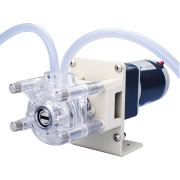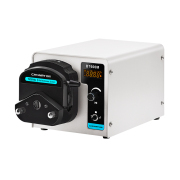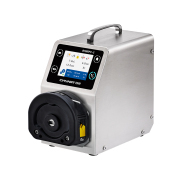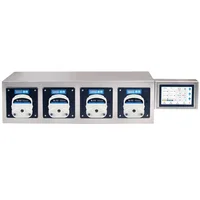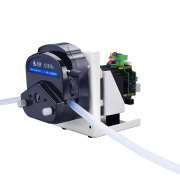Chonry Peristaltic Pump

Advantages and disadvantages of peristaltic pump
The advantages of peristaltic pump:
1, clean and pollution-free: fluid only in contact with the pump pipe, do not contact the pump body, to meet the needs of aseptic clean transport.
2, low shear transport: fluid is not shear, easy to transport shear sensitive fluid.
3, high transmission accuracy: positive displacement pump characteristics of the pump each rotation output fixed fluid, so can be used for measurement and quantitative transport.
4, can self-suction dry operation: peristaltic pump can dry operation for conveying gas, liquid, gas-liquid mixture, can transport fluid containing solid particles, solid particles diameter is up to 30% of the diameter of the hose. The vacuum produced by the peristaltic pump enables the pump to achieve self-priming, without a water filling pump before starting.
5, stop valve function no siphon: the pump tube by roller extrusion and cut off, no valve to prevent backflow and siphon.
6, positive and negative equal flow transmission: changing the steering of the motor can achieve the positive and negative direction of the liquid transmission switch, forward and reverse transmission of the same flow.
7, simple maintenance and easy to clean: hose is the only consumable material because there is no valve and seal, easy installation and simple operation, can be quickly replaced on the spot hose.
8, can transport salad sauce sticky rice glue and other viscous liquid and abrasive corrosive liquid, can also transport liquid containing solid particles.
Disadvantages of peristaltic pump:
1, the hose should be replaced regularly: the service life of the flexible hose is fixed, so it needs to be replaced regularly.
2. The output fluid has a pulse: due to the principle of peristaltic extrusion, the output liquid will produce a pulse. If the smooth transmission is required, the fluid pulse amplitude can be reduced by increasing the number of pressure wheels and increasing the pulse frequency. The increase in the number of wheels will shorten the distance between the wheels of the hose, reduce the rebound range of the hose, and reduce the flow rate. Meanwhile, the increase in the number of wheels will increase the wear of the hose and reduce the hose life.
The flow of the peristaltic pump is affected by:
Flow is an important parameter of the pump, which is affected by many factors, the main factors are:
1, hose inner diameter: the larger the inner diameter, the greater the flow.
2, the rotary diameter of the pump: the greater the diameter, the greater the flow.
3, pump speed: the higher the speed, the greater the flow.
4, the number of pressure wheels: the more the number of wheels, the smaller the flow, the more pulse generated, the smaller the pulse amplitude.
5, the viscosity of the fluid specific gravity and suction: the viscosity of the fluid, specific gravity, suction, the higher the hose rebound speed and rebound rate are lower, the transmission efficiency will be reduced, the flow will be reduced.
6. Fluid head and flow: when the head exceeds the rated pressure of the pump, the pressure generated by the liquid will squeeze the tube wall, causing the tube wall to thin, destroying the closed state of the hose and producing reflux.

0users like this.



